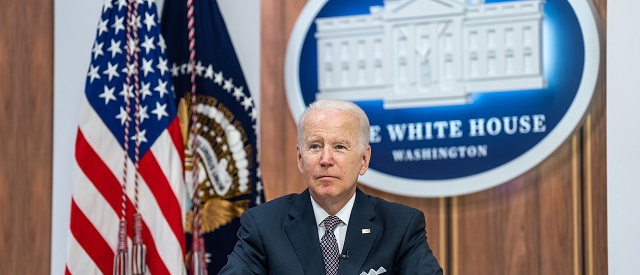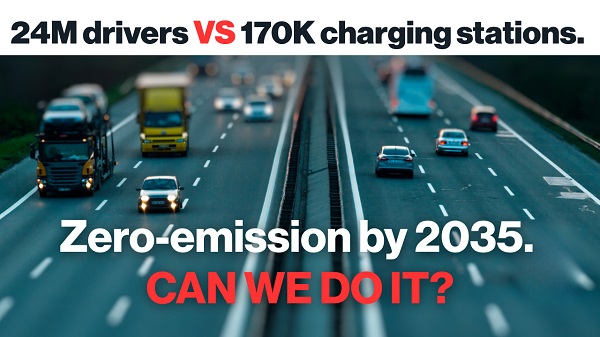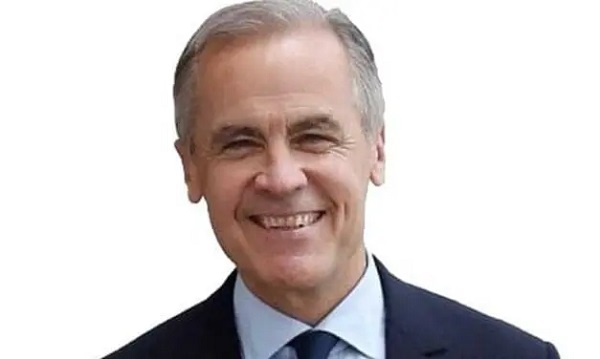Automotive
Biden’s Ambitious EV Charging ‘Fantasy’ May Be On A Collision Course With Reality

 From the Daily Caller News Foundation
From the Daily Caller News Foundation
By NICK POPE
President Joe Biden has pledged to install 500,000 public electric vehicle (EV) chargers around the U.S. by 2030, but logistical hurdles may be too much to overcome.
The Biden administration landed $7.5 billion to build out a network of public EV charging stations around the country in the bipartisan infrastructure package of 2021, but those funds have only led to a handful of operational charging stations to date. Transportation Secretary Pete Buttigieg reaffirmed the administration’s goal to build 500,000 chargers with the money by 2030 during a May television appearance on CBS News, but challenges like adding transmission lines, navigating the permitting process and coordinating with utility companies figure to make the goal improbable.
As of April 1, the administration’s $7.5 billion push had only led to seven operational charging stations combining for less than 40 chargers around the U.S., a pace that has drawn criticism from House Republicans and even Democratic Oregon Sen. Jeff Merkley. While other projects are on their way to being built and operational, the nation’s EV charging infrastructure remains mostly concentrated in more densely-populated, coastal areas of the country, according to the Department of Energy (DOE).
Dem Senator Rips Biden Official Over Sluggish Rollout Of Key EV Program pic.twitter.com/Ldj1dhJ8Jo
— Daily Caller (@DailyCaller) June 5, 2024
While results have been slow to materialize, federal funding should be sufficient to build approximately 25,000 charging spots at about 5,000 stations, according to Atlas Public Policy, a policy analysis organization that focuses specifically on EVs. In order to reach those figures by 2030, the administration’s funding will have to spur the construction of more than 900 stations each year until then, a big step up from the program’s output of less than 10 stations over nearly three years.
“Our programs are accelerating private sector investment that puts us on track to deploy 500,000 charging ports well ahead of schedule and continue to expand a convenient and reliable charging network,” a Department of Transportation spokesperson told the DCNF. “There are currently projects underway in partnership with states and local grantees for 14,000 federally-funded EV charging ports across the country under the [National Electric Vehicle Infrastructure (NEVI)] and [Charging and Fueling Infrastructure (CFI)] programs that will build on the 184,000 chargers operational today.”
Of the 184,000 chargers in operation today, more than 107,000 were already in circulation as of 2020, the last full year before the Biden administration took office, according to the DOE. Moreover, there are only about 10,000 fast charger stations in the U.S., a number that EV proponents would like to see increase to alleviate the public’s concerns about EV range and recharging wait times, according to The Washington Post.
Some of the biggest logistical hurdles are ones that may not be immediately obvious, such as enduring the process of building out needed transmission lines and upgrading existing utility infrastructure to accommodate hundreds of thousands of new chargers, according to experts who spoke with the Daily Caller News Foundation about whether such a number of chargers will be operational by 2030.
One skeptical expert is Dr. Jonathan Lesser, a senior fellow at the National Center for Energy Analytics and president of Continental Economics. Lesser estimates that “hundreds of thousands of miles” of new transmission lines will be needed to deliver enough electricity to the right places to meet the administration’s goal, a tall order given that the U.S. managed to complete less than 700 miles of transmission projects in 2022, according to data aggregated by Statista.
Lesser wrote his own analysis of the challenges the administration’s EV charger push faces for The Hill on Monday.
“The administration’s efforts to mandate EVs without considering the physical infrastructure to charge them (to say nothing of the cost), not only highway charging stations but also the necessary upgrades to millions of miles of local distribution circuits and transformers for home charging – is either an exercise in green virtue signaling or a cynical effort to restrict Americans’ mobility,” Lesser told the DCNF. “If EVs are the wave of the future then consumers will purchase them without the need for mandates and the private sector will develop the necessary infrastructure, just as it did a century ago and just as Tesla has done for its vehicles, without the need for government intervention.”
'Fundamentally Wrong': Virginia Heads For Exit Ramp After Adopting California's 'Out-Of-Touch' EV Rules https://t.co/oOKcH9Dha1
— Daily Caller (@DailyCaller) June 5, 2024
“If all those chargers were in place, you would need hundreds of thousands of large transformers and transmission lines along highways to provide the electricity,” Lesser continued. “You would also need linemen to install everything – and they are already in short supply. Of course, none of this addresses the issue of where the electricity comes from – if it is to be from renewables (e.g., wind and solar), there would have to be a massive building effort.”
Lesser believes there is “not a chance” that the 500,000 charger goal is met by 2030, and added that Buttigieg’s suggestion the administration will reach that target amounts to “pure fantasy.”
In addition to the billions of dollars meant to subsidize public charging infrastructure, the administration is also spending big to help manufacturers produce more EVs and to blunt the higher costs of EVs for consumers. Further, federal agencies have also promulgated aggressive fuel economy standards and tailpipe emissions rules that will force significant increases in EV sales over the next decade for light-, medium- and heavy-duty models.
Energy Secretary Jennifer Granholm described the chargers covered by the $7.5 billion program as “the hardest ones because they’re going to places where the private sector hasn’t gone because there’s no electricity, because they’re remote” at Politico’s 2024 Energy Summit remarks on Wednesday.
Aidan Mackenzie — an infrastructure fellow at the Institute for Progress with particular expertise covering energy, transportation and housing policy — agreed that logistical challenges are likely to hinder the administration’s goal for charger deployment by 2030. Specifically, he highlighted securing complementary infrastructure, like transmission lines, as likely to sap time and resources away from the effort to construct a national network of public chargers.
“It seems like it’s going to be hard to meet this target,” Mackenzie told the DCNF. “Different utility regions do not necessarily have an incentive to plan or build large capacity transmission lines that share power. They often interrupt the way that utilities want to control the generation in their region. So, I would very much expect that to be the binding constraint.”
However, Mackenzie added that the administration could achieve the desired results of its $7.5 billion program and its broader goal of 500,000 charger goal if regulators and builders are able to develop “muscle memory” in the earlier stages of rollout so that officials from both sectors can more easily and quickly navigate complex processes in the near future.
Automotive
Federal government should swiftly axe foolish EV mandate

From the Fraser Institute
Two recent events exemplify the fundamental irrationality that is Canada’s electric vehicle (EV) policy.
First, the Carney government re-committed to Justin Trudeau’s EV transition mandate that by 2035 all (that’s 100 per cent) of new car sales in Canada consist of “zero emission vehicles” including battery EVs, plug-in hybrid EVs and fuel-cell powered vehicles (which are virtually non-existent in today’s market). This policy has been a foolish idea since inception. The mass of car-buyers in Canada showed little desire to buy them in 2022, when the government announced the plan, and they still don’t want them.
Second, President Trump’s “Big Beautiful” budget bill has slashed taxpayer subsidies for buying new and used EVs, ended federal support for EV charging stations, and limited the ability of states to use fuel standards to force EVs onto the sales lot. Of course, Canada should not craft policy to simply match U.S. policy, but in light of policy changes south of the border Canadian policymakers would be wise to give their own EV policies a rethink.
And in this case, a rethink—that is, scrapping Ottawa’s mandate—would only benefit most Canadians. Indeed, most Canadians disapprove of the mandate; most do not want to buy EVs; most can’t afford to buy EVs (which are more expensive than traditional internal combustion vehicles and more expensive to insure and repair); and if they do manage to swing the cost of an EV, most will likely find it difficult to find public charging stations.
Also, consider this. Globally, the mining sector likely lacks the ability to keep up with the supply of metals needed to produce EVs and satisfy government mandates like we have in Canada, potentially further driving up production costs and ultimately sticker prices.
Finally, if you’re worried about losing the climate and environmental benefits of an EV transition, you should, well, not worry that much. The benefits of vehicle electrification for climate/environmental risk reduction have been oversold. In some circumstances EVs can help reduce GHG emissions—in others, they can make them worse. It depends on the fuel used to generate electricity used to charge them. And EVs have environmental negatives of their own—their fancy tires cause a lot of fine particulate pollution, one of the more harmful types of air pollution that can affect our health. And when they burst into flames (which they do with disturbing regularity) they spew toxic metals and plastics into the air with abandon.
So, to sum up in point form. Prime Minister Carney’s government has re-upped its commitment to the Trudeau-era 2035 EV mandate even while Canadians have shown for years that most don’t want to buy them. EVs don’t provide meaningful environmental benefits. They represent the worst of public policy (picking winning or losing technologies in mass markets). They are unjust (tax-robbing people who can’t afford them to subsidize those who can). And taxpayer-funded “investments” in EVs and EV-battery technology will likely be wasted in light of the diminishing U.S. market for Canadian EV tech.
If ever there was a policy so justifiably axed on its failed merits, it’s Ottawa’s EV mandate. Hopefully, the pragmatists we’ve heard much about since Carney’s election victory will acknowledge EV reality.
Automotive
Power Struggle: Electric vehicles and reality

From Resource Works
Tension grows between ambition and market truths
Host Stewart Muir talks on Power Struggle with Brian Maas, president of the California New Car Dealers Association, and Maas introduces us to a U.S. problem that Canada and B.C. also face right now. “The problem is there are mandates that apply in California and 11 other states that require, for the 2026 model year, 35% of all vehicles manufactured for sale in our state must be zero-emission, even though the market share right now is 20%. “So we’ve got a mandate that virtually none of the manufacturers our dealers represent are going to be able to meet.”
Maas adds: “We’re trying to communicate with policymakers that nobody’s opposed to the eventual goal of electrification. California’s obviously led that effort, but a mandate that nobody can comply with and one that California voters are opposed to deserves to be recalibrated.” Meanwhile, in Canada, the same objections apply to the federal government’s requirement, set in 2023, that 100% of new light-duty vehicles sold must be zero-emission vehicles, ZEVs (electric or plug-in hybrid) by 2035, with interim targets of 20 per cent by 2026 and 60 per cent by 2030. There are hefty penalties for dealers missing the targets.
Market researchers note that it now takes 55 days to sell an electric vehicle in Canada, up from 22 days in the first quarter of 2023. The researchers cite a lack of desirable models and high consumer prices despite government subsidies to buyers in six provinces that run as high as $7,000 in Quebec.
In the U.S. The Wall Street Journal reports that, on average, electric vehicles and plug-in hybrids sit in dealer lots longer than gasoline-powered cars and hybrids, despite government pressure to switch to electric. (The Biden administration ruled that two-thirds of new vehicles sold must be electric by 2032.) For Canada, the small-c conservative Fraser Institute reports: “The targets were wild to begin with. As Manhattan Institute senior fellow Mark P. Mills observed, bans on conventional vehicles and mandated switches to electric means, consumers will need to adopt EVs at a scale and velocity 10 times greater and faster than the introduction of any new model of car in history.”
When Ottawa scrapped federal consumer subsidies earlier this year, EV manufacturers and dealers in Canada called on the feds to scrap the sales mandates. “The federal government’s mandated ZEV sales targets are increasingly unrealistic and must end,” said Brian Kingston, CEO of the Canadian Vehicle Manufacturers’ Association. “Mandating Canadians to buy ZEVs without providing them the supports needed to switch to electric is a made-in-Canada policy failure.” And Tim Reuss, CEO of the Canadian Automobile Dealers Association, said: “The Liberal federal government has backed away from supporting the transition to electric vehicles and now we are left with a completely unrealistic plan at the federal level. “There is hypocrisy in imposing ambitious ZEV mandates and penalties on consumers when the government is showing a clear lack of motivation and support for their own policy goals.”
In B.C., sales growth of ZEVs has recently slowed, and the provincial government is considering easing its ZEV targets. “The Energy Ministry acknowledged that it will be ‘challenging’ to reach the target that 90 per cent of new vehicles be zero emission by 2030.” Nat Gosman, an assistant deputy minister in the B.C. energy ministry, cited reasons for the slowdown that include affordability concerns due to a pause in government rebates, supply chain disruptions caused by U.S. tariffs, and concerns about reliability of public charging sites.
Barry Penner, chair of the Energy Futures Institute and a former B.C. Liberal environment minister, said the problem is that the government has “put the cart before the horse” when it comes to incentivizing people to buy electric vehicles. “The government imposed these electric vehicle mandates before the public charging infrastructure is in place and before we’ve figured out how we’re going to make it easy for people to charge their vehicles in multi-family dwellings like apartment buildings.”
Penner went on to write an article for Resource Works that said: “Instead of accelerating into economically harmful mandates, both provincial and federal governments should recalibrate. We need to slow down, invest in required charging infrastructure, and support market-based innovation, not forced adoption through penalties. “A sustainable energy future for BC and Canada requires smart, pragmatic policy, not economic coercion. Let’s take our foot off the gas and realign our policies with reality, protect jobs, consumer affordability, and real environmental progress. Then we can have a successful transition to electric vehicles.”
Back to Power Struggle, and Brian Maas tells Stewart: “I think everybody understands that it’s great technology and I think a lot of Californians would like to have one. . . . The number one reason consumers cited for not making the transition to a zero-emission vehicle is the lack of public charging infrastructure. We’re woefully behind what would be required to move to 100% environment. “And if you live in a multifamily dwelling, an apartment building or something like that, you can’t charge at home, so you would have to rely on a public charger. Where do you go to get that charged?
“The state’s Energy Commission has said we need a million public chargers by 2030 and two million public chargers by 2035. We only have 178,000 now and we’re adding less than 50,000 public chargers a year. We’re just not going to get there fast enough to meet the mandate that’s on the books now.”
In Canada, Resource Works finds there now are more than 33,700 public charging ports, at 12,955 locations. But Ottawa says that to support its EV mandate, Canada will need about 679,000 public ports. “This will require the installation of, on average, 40,000 public ports each year between 2025 and 2040.”
And we remind readers of Penner’s serious call on governments to lighten the push on the accelerator when it comes to ZEV mandates: “Let’s take our foot off the gas and realign our policies with reality, protect jobs, consumer affordability, and real environmental progress. Then we can have a successful transition to electric vehicles.”
- Power Struggle YouTube video: https://ow.ly/8J4T50WhK5i
- Audio and full transcript: https://ow.ly/Np8550WhK5j
- Stewart Muir on LinkedIn: https://ow.ly/Smiq50UWpSB
- Brian Maas on LinkedIn: https://ow.ly/GuTh50WhK8h
- Power Struggle on LinkedIn: https://ow.ly/KX4r50UWpUa
- Power Struggle on Instagram: https://ow.ly/3VIM50UWpUg
- Power Struggle on Facebook: https://ow.ly/4znx50UWpUs
- Power Struggle on X: https://ow.ly/tU3R50UWpVu
-

 Daily Caller2 days ago
Daily Caller2 days agoBlackouts Coming If America Continues With Biden-Era Green Frenzy, Trump Admin Warns
-

 Daily Caller2 days ago
Daily Caller2 days ago‘I Know How These People Operate’: Fmr CIA Officer Calls BS On FBI’s New Epstein Intel
-

 International2 days ago
International2 days agoChicago suburb purchases childhood home of Pope Leo XIV
-

 Daily Caller12 hours ago
Daily Caller12 hours agoUSAID Quietly Sent Thousands Of Viruses To Chinese Military-Linked Biolab
-

 Addictions12 hours ago
Addictions12 hours ago‘Over and over until they die’: Drug crisis pushes first responders to the brink
-

 Business1 day ago
Business1 day agoPrime minister can make good on campaign promise by reforming Canada Health Act
-

 Automotive10 hours ago
Automotive10 hours agoFederal government should swiftly axe foolish EV mandate
-

 Alberta9 hours ago
Alberta9 hours ago‘Far too serious for such uninformed, careless journalism’: Complaint filed against Globe and Mail article challenging Alberta’s gender surgery law







